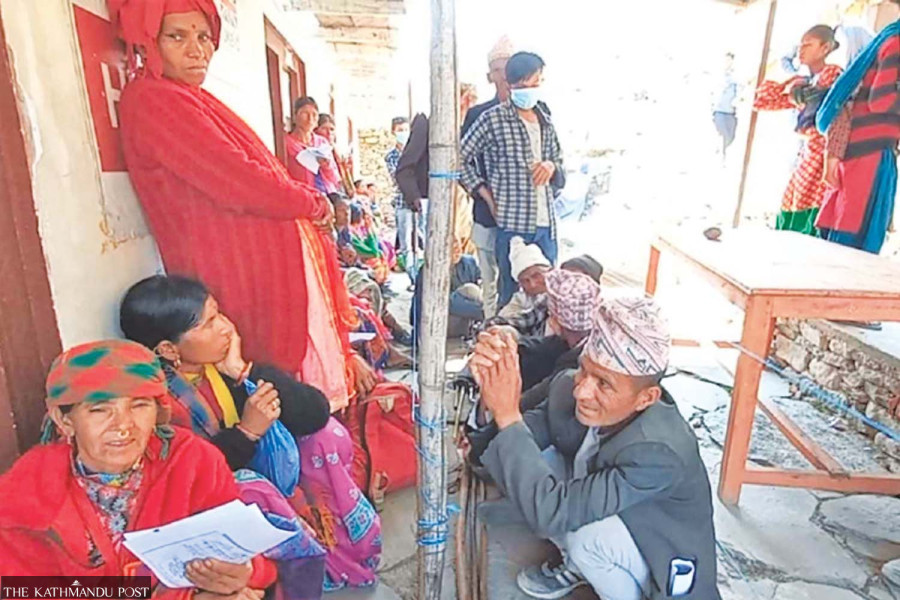National
Social security beneficiaries down by almost 200,000
Electronic fund transfers have reduced duplication.
Prithivi Man Shrestha
For the first time in several years, there has been a notable decline in the number of beneficiaries of social security allowances by almost 200,000.
Figures provided by the Department of National ID and Civil Registration have revealed that the number of beneficiaries, at the end of the second quarter of the current fiscal year, has been cut to 3.62 million from last fiscal’s 3.8 million. There was a decrease in total beneficiaries by 176,690 in the first six months of 2023-24.
At a time the liability for social security has been rising, the fall in the number of beneficiaries has come as a welcome relief to the government, which has been struggling to generate resources in the past few years.
“The main reason behind the reduction in the number of beneficiaries is the removal of duplicate entries. This happened after we started sending money directly to bank accounts of the beneficiaries through the electronic fund transfer system,” said Yubaraj Kattel, director general at the department.
“We have been using the system to deposit money into beneficiaries' accounts since the end of the second quarter of this fiscal year.”
According to the department, there has been a decline in the number of beneficiaries in several categories. The number of elderly beneficiaries aged over 68 years, elderly single women, Dalit children, children (designated areas) and children of endangered communities decreased during the period.
For example, the number of elderly beneficiaries aged over 68 years has come down to 1,602,564 by mid-January 2024 from 1,607,296 in mid-July last year. Likewise, the number of Dalit children has fallen to 328,332 from 368,722.
“In the past, we used to send the money to the banks and they would then deposit the allowances in the beneficiaries’ accounts,” said Kattel. “Under this arrangement, there was the risk that a beneficiary with multiple bank accounts could receive allowances in each of them.”
Now, the department is working to integrate the National ID and social security allowance processes. The department plans to integrate all individuals into the national ID card system. “This will further streamline the beneficiary process, leading to more reduction in the number of beneficiaries,” Kattel said.
Though the department expects a decline in the total number of beneficiaries by the end of the current fiscal year, some beneficiaries whose bank accounts are no longer active may also not receive allowances. “We cannot deny the allowance to such beneficiaries but their number is expected to be small,” said Kattel.
No decision has been made on what happens to the beneficiaries who have received social security allowance multiple times in multiple bank accounts.
“There may be an investigation on the matter,” he said to Kattel. “We also cannot rule out the possibility of single beneficiaries holding multiple bank accounts unduly benefitting under the influence of people in power.”
In recent years, there has been a race among political parties to either increase the social security allowance, ease eligibility criteria, or widen its coverage.
In the fiscal year 2022-23, the Sher Bahadur Deuba-led government lowered the eligibility age for the elderly from 70 years to 68 years, leading to a sudden rise in the number of elderly allowance beneficiaries, by nearly 300,000. An elderly beneficiary receives Rs4,000 a month as allowance.
In the fiscal year 2021-22, the then KP Sharma Oli government had increased all social security allowances by 33 percent, including the elderly allowance to Rs4,000 a month from Rs3,000 a month.
Then the Deuba-led coalition government, which came to power in July 2021, decided to lower the eligibility age for the elderly allowance.
As a result, the government’s expenses on social security, based on cash transfers, had been rising. In the fiscal year 2020-21, the government spent Rs68.61 billion on social security allowances, and this rose to Rs95.97 billion in 2021-22, and to Rs112 billion in the fiscal year 2022-23.
Experts have long been cautioning the government about the long-term impacts of the growing social security burden.
At least in the short-term, the department hopes to save some money due to the electronic cash transfer system.
“Our estimate is that at least Rs3 billion will be saved in the current fiscal year,” said Kattel.




 17.29°C Kathmandu
17.29°C Kathmandu















